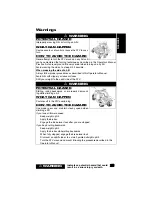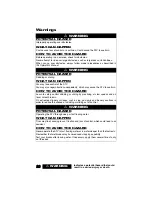
PRE
VENTION
! WARNING
Indicates a potential hazard that could
result in a serious injury or death.
21
Prevention
B. Throttle
The throttle should have a free, smooth
range of motion. If it seems to “stick” at
any point, refer to the General Mainte-
nance section of this Operator’s Manual
for instructions. Driving your ATV with
a sticking throttle can turn your leisurely
ride into an unwelcome accident. Don’t
drive your ATV if the throttle sticks.
3. LIGHTS AND
ELECTRIC
Turn the hi-beam and lo-beam on and
off to make sure they work. At the
same time, check that the taillight and
brakelight work. Also, check the status/
warning indicators (reverse, neutral,
and hi-lo beam) on the handlebars
when you start the ATV. Don’t drive
the ATV unless all systems are work-
ing. Check the ignition switch and
engine stop switch.
4. OIL AND FUEL
Start with a full tank of gas before
every ride, and while you’re at it, top
off the oil. Don’t forget to check for
fluid leaks around the ATV. Watch the
overheat indicator to ensure the engine
coolant level is adequate.
5. CHASSIS
Grass and leaves can gum-up your sus-
pension and shocks. Clear and clean
the suspension arms, shock springs,
and fenders. Check smoothness by
turning the handlebar full-left and full-
right. Check that there is no binding,
restrictions, free-play, or looseness in
steering components.
6. MISCELLANEOUS
ITEMS
Inspect your air filter. Look for debris
or damage that may indicate you need
to replace it. A clogged filter can stop
an engine. Check your battery termi-
nals for corrosion. Also, be sure to
tighten any loose parts, nuts, or bolts.
You need to prepare for the unex-
pected. Emergencies and accidents are
traumatic enough, but they’re even
worse when you’re not prepared for
them. At the minimum during every
ATV ride, you should have the follow-
ing items on board:
• Tools
• Water
• Identification
• First Aid Kit
For rides that are longer in duration and
distance, the following additional items
are recommended:
Check:
1. Free, smooth range of motion
Check:
1. Hi-beam
2. Lo-beam
3. Taillight/brakelight
4. Status/warning indicators
5. Ignition switch
6. Stop switch
Check:
1. Gas
2. Oil
3. Fluid leaks
First Aid and Survival
Check:
1. Suspension arms
2. Shock springs
3. Fenders
4. Steering
Check:
1. Air filter
2. Battery
3. Tighten parts, nuts, and bolts
















































